

How to Build a 4-Channel Wireless Sensor System. Search around online IoT communities and resource sites such as thingspeak and you can find several examples of Wi-Fi-based, Arduino-sourced projects that include a popular wireless sensor application using a HDT11 humidity and temperature sensor.
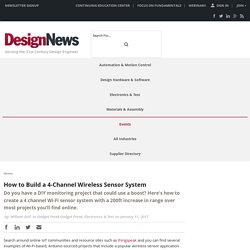
These projects have a number of applications in garden, home, and other automation and monitoring projects, including environmental applications, resource, and utility monitoring. However, the simplest systems are constrained in that they require both a Wi-Fi environment and that they must be located within some fixed distance from the wireless router. While this may be overcome with cell based systems, when creating local hotspots you still have limits location and perhaps cost return issues. The hardware is based on a MicroChip 12F509 (transmitter) and 16F676 controller for the receiver. The application uses an inexpensive 433MHZ (up to 4) transmitters and a single receiver. Firmware Over The Air (FOTA) for ESP8266 SoC. With the IoT booming nowadays, the number of connected devices grows exponentially and so does the related software that drives them.
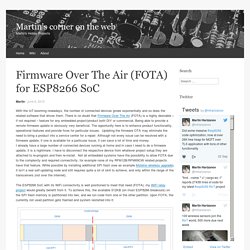
There is no doubt that Firmware Over The Air (FOTA) is a highly desirable – if not required – feature for any embedded project/product both DIY or commercial. Being able to provide a remote firmware update is obviously very beneficial. The opportunity here is to enhance product functionality, operational features and provide fixes for particular issues. Updating the firmware OTA may eliminate the need to bring a product into a service center for a repair. Libraries · ESP8266 Arduino Core. Table of Contents This is mostly similar to WiFi shield library.
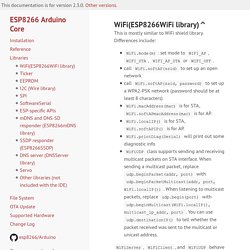
Differences include: WiFi.mode(m): set mode to WIFI_AP, WIFI_STA, WIFI_AP_STA or WIFI_OFF.call WiFi.softAP(ssid) to set up an open networkcall WiFi.softAP(ssid, password) to set up a WPA2-PSK network (password should be at least 8 characters)WiFi.macAddress(mac) is for STA, WiFi.softAPmacAddress(mac) is for AP.WiFi.localIP() is for STA, WiFi.softAPIP() is for AP.WiFi.printDiag(Serial) will print out some diagnostic infoWiFiUDP class supports sending and receiving multicast packets on STA interface. When sending a multicast packet, replace udp.beginPacket(addr, port) with udp.beginPacketMulticast(addr, port, WiFi.localIP()). When listening to multicast packets, replace udp.begin(port) with udp.beginMulticast(WiFi.localIP(), multicast_ip_addr, port). IBM Watson IoT - IoT Developer. Connect and manage your devices, gateways and applications.
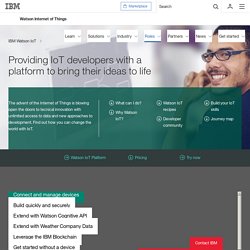
Connect to the IBM Watson IoT Platform on IBM Bluemix® with ease, then set up and manage your IoT devices and data to start creating your own applications, visualization dashboards and mobile IoT apps. APIs and Docs Quick Connect your mobile phone or other device to demo application: Play. Web of Things Platforms Tutorial. Overview - ARTIK Cloud Developers. MicroPython on the ESP8266: Kicking the Tires. Scripting languages are for large computers, right?
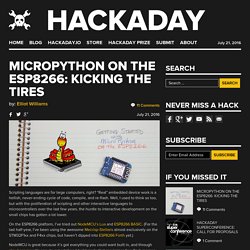
“Real” embedded device work is a hellish, never-ending cycle of code, compile, and re-flash. Well, I used to think so too, but with the proliferation of scripting and other interactive languages to microcontrollers over the last few years, the hurdle to interactive development on the small chips has gotten a lot lower. On the ESP8266 platform, I’ve tried out NodeMCU’s Lua and ESP8266 BASIC. (For the last half-year, I’ve been using the awesome Mecrisp-Stellaris almost exclusively on the STM32F1xx and F4xx chips, but haven’t dipped into ESP8266 Forth yet.) NodeMCU is great because it’s got everything you could want built in, and through cloud services it’s easy to get a tailored build made that maximizes free flash memory for your projects.
So when the MicroPython folks announced that they were releasing the binary builds for the ESP, I thought it was time to give it a spin. Installation That was easy. Getting Settled In. QIoT Containers. Realtime Bus Map - EON Realtime Dashboards. Electric Imp imp003 Product Brief 02May2016. Estimote Beacons — real world context for your apps. Nabto - Communication Platform for IoT. First IoT Project Builder - myDevices Cayenne. Official ThingSpeak Library for Arduino and Particle.
09Oct 15 We are thrilled to announce the official ThingSpeak Communication Library for Arduino and Particle devices.

This library enables an Arduino or other compatible hardware to write or read data to or from ThingSpeak, an open data platform for the Internet of Things with built-in MATLAB analytics and visualization apps. Arduino IDE Installation In the Arduino IDE, choose Sketch/Include Library/Manage Libraries. Click the ThingSpeak Library from the list, and click the Install button. Particle / Spark IDE Installation In the Particle/ Spark Web IDE, click the libraries tab, find ThingSpeak, and choose “Include in App”. Compatible Hardware. ProtoSnap Development Board Simple. Sensors : Arduino Store - community and electronics. Build your connected product. Code-Free IoT with Arduino and The Tentacle on Octoblu! - Hackster.io. If you want to do anything in the Internet of Things space, there's nothing easier to do it than to use Octoblu.
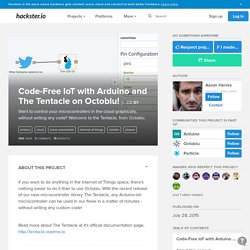
With the recent release of our new microcontroller library The Tentacle, any Arduino-ish microcontroller can be used in our flows in a matter of minutes - without writing any custom code! Read more about The Tentacle at it's official documentation page, Getting an Octoblu Account first step when it comes to connecting a microcontroller to Octoblu is to, well, get an account with Octoblu. Cylon.js - JavaScript framework for robotics, physical computing, and the Internet of Things using Node.js. Microduino mCookie: The smallest electronic modules on LEGO® by Microduino Studio. And check more on Microduino website or wiki We provide 3 mCookie kits in this Kickstarter campaign, including 101 Basic kit, 201 Advanced kit and 301 Expert kit.
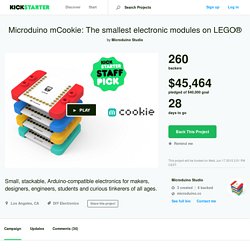
There are different mCookie modules and sensors in each kit. The Microduino team has worked hard to make this a compelling product and to offer it at a great price for Kickstarter backers. JIBO. Raspberry Pi - Internet of Things. Freescale Kinetis based Mbed IoT Starter Kit Ethernet Edition Connects to IBM IoT Cloud. Spark Core - Créez vos objets connectés #IOT. Le Spark core, un petit micro-contrôleur sur-équipé, doté d’un module WiFi et de mémoire est dans ma ToDoList d’articles depuis plusieurs mois.
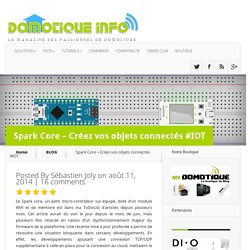
Cet article aurait du voir le jour depuis le mois de juin, mais plusieurs fois retardé en raison d’un dysfonctionnement majeur du Firmware de la plateforme. Une récente mise à jour profonde a permis de résoudre une situation bloquante dans certains développements. En effet, les développements ajoutant une connexion TCP/UDP supplémentaire à celle en place pour la connexion au cloud, mettaient le dispositif en situation de gel ou de reboot de manière inopinée et périodique. Parce que ce problème est aujourd’hui résolu, je reviens à mon clavier pour vous présenter le Spark core. Après plus de 2 mois d’utilisation, je vous propose un article découverte du Spark core. Cet article vous propose une vision globale et synthétique des perspectives que le Spark core peut offrir dans le domaine de la domotique.
Pré-requis : 2.1 – Microcontrôleur. Open source IoT toolkit. Web des Objets - Le site des objets connectés.